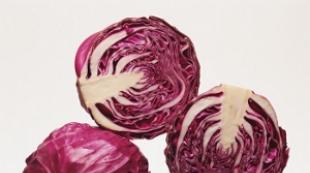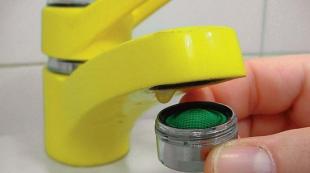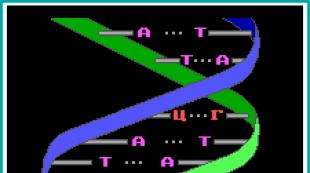The total mass of all DNA molecules. Determine what is the mass of all DNA molecules What is the "packing" of a molecule
The topics Molecular Biology and Genetics are the most interesting and challenging topics in the General Biology course. These topics are studied in both the 9th and 11th grades, but there is clearly not enough time to practice the ability to solve problems in the program. However, the ability to solve problems in genetics and molecular biology is provided for by the Standard of Biological Education, and such tasks are also part of the CIM USE.
To solve problems in molecular biology, it is necessary to master the following biological concepts: types of nucleic acids, DNA structure, DNA replication, DNA functions, RNA structure and functions, genetic code, properties of the genetic code, mutation.
Typical problems introduce the basic methods of reasoning in genetics, and "plot" ones - more fully reveal and illustrate the features of this science, making it interesting and attractive for students. The selected problems characterize genetics as an exact science that uses mathematical methods of analysis. Problem solving in biology requires the ability to analyze factual material, think logically and reason, as well as a certain ingenuity in solving especially difficult and confusing problems.
To consolidate the theoretical material on the methods and techniques for solving problems, tasks for independent solutions are proposed, as well as questions for self-control.
Examples of problem solving
Required explanations:
- One step is a complete turn of the DNA helix - 360 o turn
- One step is 10 base pairs
- One step length - 3.4 nm
- Distance between two nucleotides - 0.34 nm
- Molecular weight of one nucleotide - 345 g / mol
- The molecular weight of one amino acid is 120 g / mol
- In a DNA molecule: A + G = T + C (Chargaff's rule: ∑ (A) = ∑ (T), ∑ (G) = ∑ (C), ∑ (A + G) = ∑ (T + C)
- Nucleotide complementarity: A = T; G = C
- DNA chains are held together by hydrogen bonds, which are formed between complementary nitrogenous bases: adenine with thymine are linked by 2 hydrogen bonds, and guanine with cytosine by three.
- On average, one protein contains 400 amino acids;
- calculating the molecular weight of a protein:
Where M min is the minimum molecular weight of the protein,
a is the atomic or molecular weight of the component,
в - the percentage of the component.
Problem number 1.
One of the DNA strands has a nucleotide sequence: AGT ACC GAT ACT CGA TTT ACG ... What is the nucleotide sequence of the second DNA strand of the same molecule. For clarity, you can use the magnetic "alphabet" of DNA (method of the author of the article).
Solution: according to the principle of complementarity, we complete the second chain (AT, G-C). It looks as follows: TCA TGG CTA TGA GCT AAA TGC.
Problem number 2.
The sequence of nucleotides at the beginning of the gene that stores information about the protein insulin begins like this: AAA TsAC TsTG TsTT GTA GAC. Write the amino acid sequences that start the insulin chain.
Solution: The task is performed using the genetic code table, in which the nucleotides in the mRNA (in parentheses - in the original DNA) correspond to amino acid residues.
Problem number 3. The larger of the two chains of the insulin protein has (the so-called B chain) begins with the following amino acids: phenylalanine-valine-asparagine-glutamic acid-histidine-leucine. Write the sequence of nucleotides at the beginning of the section of the DNA molecule that stores information about this protein.
since one amino acid can be encoded by several triplets, the exact structure of i-RNA and DNA site cannot be determined, the structure can vary. Using the principle of complementarity and the genetic code table, we get one of the options:
Problem number 4. A region of a gene has the following structure, consisting of a sequence of nucleotides: CHG CHC TCA AAA TCG ... Indicate the structure of the corresponding protein region, information about which is contained in this gene. How will the removal of the fourth nucleotide from the gene affect the structure of the protein?
Solution (for convenience, we use the tabular form of the solution):
When the fourth nucleotide - C is removed from the gene, noticeable changes will occur - the number and composition of amino acids in the protein will decrease:
Problem number 5. The tobacco mosaic virus (RNA-containing virus) synthesizes a protein region with the amino acid sequence: Ala - Tre - Ser - Glu - Met-. Under the action of nitrous acid (mutagenic factor), cytosine is converted into uracil as a result of deamination. What is the structure of the tobacco mosaic virus protein region if all cytidyl nucleotides undergo the specified chemical transformation?
Solution (for convenience, we use the tabular form of the solution): Using the principle of complementarity and the genetic code table, we get:
Problem number 6. In Fancomi syndrome (violation of bone formation), the patient excretes urine amino acids, which correspond to codons in and -RNA: AUA GUTS AUG UCA UUG GUU AUU. Determine the excretion of which amino acids in the urine is characteristic of Fancomy's syndrome, if a healthy person contains the amino acids alanine, serine, glutamic acid, glycine in the urine.
Solution (for convenience, we use the tabular form of the solution): Using the principle of complementarity and the genetic code table, we get:
Thus, in the urine of a sick person, only one amino acid (serine) is the same as in a healthy person, the rest are new, and three, characteristic of a healthy person, are absent.
Problem number 7. The bovine insulin chain A in the 8th link contains alanine, and in the horse - threonine, in the 9th link, respectively, serine and glycine. What about the origin of insulins?
Solution (for convenience of comparison, we use the tabular form of the solution): Let's see what triplets in m-RNA are encoded the amino acids mentioned in the problem statement.
| Organism | Horse |
|
Because amino acids are encoded by different triplets, triplets are taken that are minimally different from each other. In this case, in a horse and a bull in the 8th and 9th links, amino acids are changed as a result of the replacement of the first nucleotides in the triplets and -RNA: guanine is replaced by adenine (or vice versa). In double-stranded DNA, this will be equivalent to replacing the C-G pair with a T-A pair (or vice versa).
Consequently, the differences between the A chains of bovine and horse insulin are due to transitions in the region of the DNA molecule encoding the 8th and 9th links of the A chain of the bovine and horse insulin.
Problem number 7.
Studies have shown that m-RNA contains 34% guanine, 18% uracil, 28% cytosine and 20% adenine. Determine the percentage of nitrogenous bases in the DNA region that is a template for this m-RNA.
Solution (for convenience, we use the tabular form of the solution): We calculate the percentage of nitrogenous bases based on the principle of complementarity:
In total, A + T and G + C in the semantic chain will be: A + T = 18% + 20% = 38%; G + C = 28% + 34% = 62%. In the antisense (non-coded) chain, the total indicators will be the same, only the percentage of individual bases will be reversed: A + T = 20% + 18% = 38%; G + C = 34% + 28% = 62%. In both chains, the pairs of complementary bases will be equally divided, i.e. adenine and thymine - 19% each, guanine and cytosine - 31% each.
Problem number 8. On a fragment of one DNA strand, nucleotides are located in the sequence: A – A – G – T – C – T – A – C – G – T – A – T. Determine the percentage of all nucleotides in this DNA fragment and the length of the gene.
Solution:
1) we finish building the second thread (according to the principle of complementarity)
2) ∑ (A + T + C + G) = 24, of which ∑ (A) = 8 = ∑ (T)
| 24 – 100% | => x = 33.4% |
=> x = 16.6% |
|
∑ (Г) = 4 = ∑ (Ц)
3) the DNA molecule is double-stranded, so the length of the gene is equal to the length of one chain:
12 × 0.34 = 4.08 nm
Problem number 9. In the DNA molecule, cytidyl nucleotides account for 18%. Determine the percentage of other nucleotides in this DNA.
Solution:
1) since C = 18%, then G = 18%;
2) A + T accounts for 100% - (18% + 18%) = 64%, i.e. 32% each
Problem number 10. The DNA molecule contains 880 guanidyl nucleotides, which make up 22% of the total number of nucleotides in this DNA. Determine: a) how many other nucleotides are in this DNA? b) how long is this fragment?
Solution:
1) ∑ (Г) = ∑ (Ц) = 880 (this is 22%); The share of other nucleotides is 100% - (22% + 22%) = 56%, i.e. 28% each; To calculate the number of these nucleotides, we make up the proportion:
22% – 880
28% - x, hence x = 1120
2) to determine the length of DNA, you need to find out how many nucleotides are contained in 1 chain:
(880 + 880 + 1120 + 1120) : 2 = 2000
2000 × 0.34 = 680 (nm)
Problem number 11. Given a DNA molecule with a relative molecular weight of 69,000, of which 8625 are adenyl nucleotides. Find the number of all nucleotides in this DNA. Determine the length of this piece.
Solution:
1) 69,000: 345 = 200 (nucleotides in DNA), 8625: 345 = 25 (adenyl nucleotides in this DNA), ∑ (G + C) = 200 - (25 + 25) = 150, i.e. there are 75 of them;
2) 200 nucleotides in two chains, which means in one - 100.100 × 0.34 = 34 (nm)
Problem number 12. Which is heavier: a protein or its gene?
Solution: Let x be the number of amino acids in a protein, then the mass of this protein is 120x, the number of nucleotides in the gene encoding this protein is 3x, the mass of this gene is 345 × 3x. 120x< 345 × 3х, значит ген тяжелее белка.
Problem number 13. Human blood hemoglobin contains 0.34% iron. Calculate the minimum molecular weight of hemoglobin.
Solution: M min = 56: 0.34% 100% = 16471
Problem number 14. Human serum albumin has a molecular weight of 68400. Determine the number of amino acid residues in the molecule of this protein.
Solution: 68400: 120 = 570 (amino acids in the albumin molecule)
Problem number 15. Protein contains 0.5% glycine. What is the minimum molecular weight of this protein if M glycine = 75.1? How many amino acid residues are in this protein?
Solution: M min = 75.1: 0.5% 100% = 15020; 15020: 120 = 125 (amino acids in this protein)
Self-study tasks
- The DNA molecule has split into two strands. one of them has the structure: TAG ACT GGT ACA CGT GGT GAT TCA ... What structure will the second DNA molecule have when the specified chain is completed to a complete double-stranded molecule?
- The polypeptide chain of one animal protein has the following beginning: lysine-glutamine-threonine-alanine-alanine-alanine-lysine -... What nucleotide sequence does the gene corresponding to this protein start with?
- A portion of the protein molecule has the following amino acid sequence: glutamine-phenylalanine-leucine-tyrosine-arginine. Determine one of the possible nucleotide sequences in the DNA molecule.
- A portion of the protein molecule has the following amino acid sequence: glycine-tyrosine-arginine-alanine-cysteine. Determine one of the possible nucleotide sequences in the DNA molecule.
- One of the chains of ribonuclease (pancreatic enzyme) consists of 16 amino acids: Glu-Gly-asp-Pro-Tyr-Val-Pro-Val-Pro-Val-Gis-fen-Fen-Asn-Ala-Ser-Val. Determine the structure of the region of DNA encoding this part of ribonuclease.
- A fragment of the DNA gene has the following nucleotide sequence GTC CTA ACC GHA TTT. Determine the sequence of nucleotides of m-RNA and amino acids in the polypeptide chain of the protein.
- The DNA gene fragment has the following nucleotide sequence TCG GTZ AAC TTA GCT. Determine the sequence of nucleotides of m-RNA and amino acids in the polypeptide chain of the protein.
- The DNA gene fragment has the following nucleotide sequence THG ACA GGT TTTS GTA. Determine the sequence of nucleotides of m-RNA and amino acids in the polypeptide chain of the protein.
- Determine the sequence of amino acids in a region of a protein molecule if it is known that it is encoded by the following DNA nucleotide sequence: TGA THC GTT TAT GCH CCC. How will the protein change if the 9th and 13th nucleotides are chemically removed?
- The coding DNA strand has a nucleotide sequence: TAG CGT TTTS TCG GTA. How the structure of a protein molecule will change if there is a doubling of the sixth nucleotide in the DNA chain. Explain the results.
- The coding DNA strand has a nucleotide sequence: TAG TTC TCG AGA. How the structure of a protein molecule will change if there is a doubling of the eighth nucleotide in the DNA chain. Explain the results.
- Under the influence of mutagenic factors in the gene fragment: CAT TAG GTA CGT TCG, the second triplet was replaced by the ATA triplet. Explain how the structure of the protein molecule will change.
- Under the influence of mutagenic factors in the gene fragment: AGA TAG GTA CGT TCG, the fourth triplet was replaced by the ACC triplet. Explain how the structure of the protein molecule will change.
- A fragment of the i-RNA molecule has the following nucleotide sequence: HCA UGU AGC AAG CGC. Determine the sequence of amino acids in a protein molecule and its molecular weight.
- A fragment of the i-RNA molecule has the following nucleotide sequence: GAG CCA AAU ACU UUA. Determine the sequence of amino acids in a protein molecule and its molecular weight.
- The DNA gene contains 450 base pairs. What is the length, molecular weight of the gene, and how many amino acids are encoded in it?
- How many nucleotides does a DNA gene contain if 135 amino acids are encoded in it? What is the molecular weight and length of this gene?
- A fragment of one DNA strand has the following structure: GGT ACG ATG TCA AGA. Determine the primary structure of the protein encoded in this chain, the amount (%) of different types of nucleotides in the two chains of the fragment and its length.
- What is the molecular weight of a gene and its length if it encodes a protein with a molecular weight of 1500 g / mol?
- What is the molecular weight of a gene and its length if it encodes a protein with a molecular weight of 42,000 g / mol?
- The protein molecule contains 125 amino acids. Determine the number of nucleotides in the m-RNA and DNA gene, as well as the number of t-RNA molecules that took part in the synthesis of this protein.
- The protein molecule contains 204 amino acids. Determine the number of nucleotides in the m-RNA and DNA gene, as well as the number of t-RNA molecules that took part in the synthesis of this protein.
- The synthesis of the protein molecule involved 145 t-RNA molecules. Determine the number of nucleotides in the m-RNA, the DNA gene and the number of amino acids in the synthesized protein molecule.
- The synthesis of the protein molecule involved 128 t-RNA molecules. Determine the number of nucleotides in the m-RNA, the DNA gene and the number of amino acids in the synthesized protein molecule.
- A fragment of the m-RNA chain has the following sequence: GGG UGG UAU CCC AAC USU. Determine the nucleotide sequence on DNA, t-RNA anticodons, and the amino acid sequence corresponding to the DNA gene fragment.
- A fragment of the m-RNA chain has the following sequence: GUU GAA TsCH UAU GCC. Determine the nucleotide sequence on DNA, t-RNA anticodons, and the amino acid sequence corresponding to the DNA gene fragment.
- The i-RNA molecule contains 13% adenyl, 27% guanyl and 39% uracil nucleotides. Determine the ratio of all types of nucleotides in the DNA from which this m-RNA was transcribed.
- The i-RNA molecule contains 21% cytidyl, 17% guanyl and 40% uracil nucleotides. Determine the ratio of all types of nucleotides in the DNA with which this m-RNA was transcribed
- The i-RNA molecule contains 21% guanyl nucleotides, how many cytidyl nucleotides are there in the coding strand of a DNA region?
- If the chain of the DNA molecule with which the genetic information is transcribed contained 11% adenyl nucleotides, how many uracil nucleotides will be contained in the corresponding segment of m-RNA?
Used Books.
- Bolgova I.V. Collection of problems in general biology with solutions for applicants to universities - M .: Onyx Publishing House: Publishing House. Peace and Education, 2008.
- Vorobiev O.V. Biology lessons with the use of information technology. Grade 10. Methodical manual with electronic attachment-M.: Planet, 2012.
- Cherednichenko I.P. Biology. Interactive didactic materials. Grade 6-11. Methodical manual with an electronic interactive application. - M.: Planet, 2012.
- Internet links:
Depending on which monosaccharide is contained in the structural unit of the polynucleotide - ribose or 2-deoxyribose, distinguish
- ribonucleic acids(RNA) and
- deoxyribonucleic acids(DNA).
Nucleotide units of DNA macromolecules may contain adenine, guanine, cytosine and thymine... The composition of RNA differs in that instead of thymine is present uracil.
The molecular weight of DNA reaches tens of millions of amu. These are the longest known macromolecules. The molecular weight of RNA is much lower (from several hundred to tens of thousands). DNA is found mainly in the nuclei of cells, RNA - in the ribosomes and protoplasm of cells.
When describing the structure of nucleic acids, different levels of organization of macromolecules are taken into account: primary and secondary structure.
- Primary structure nucleic acids are the nucleotide composition and a specific sequence of nucleotide units in a polymer chain.
In an abbreviated one-letter notation, this structure is written as ...– A - G - C –...
- Under secondary structure nucleic acids are understood to be spatially ordered forms of polynucleotide chains.

This spatial structure is held together by many hydrogen bonds formed by nitrogenous bases directed towards the inside of the helix. Hydrogen bonds arise between the purine base of one chain and the pyrimidine base of the other chain. These bases make up complementary pairs (from lat. complementum- addition). The formation of hydrogen bonds between complementary base pairs is due to their spatial correspondence. The pyrimidine base is complementary to the purine base:

Hydrogen bonds between other base pairs prevent them from being accommodated in the double helix structure. Thus,
- THYMINE (T) is complementary to Adenine (A),
- CYTOSINE (C) is complementary to GUANINE (G).

The complementarity of polynucleotide chains is the chemical basis of the main function of DNA - storage and transmission of hereditary traits.
The ability of DNA not only to store, but also to use genetic information is determined by its following properties:
Secondary structure of RNA... Unlike DNA, RNA molecules consist of a single polynucleotide chain and do not have a strictly defined spatial shape (the secondary structure of RNA depends on their biological functions).
The main role of RNA is its direct participation in protein biosynthesis. There are three types of cellular RNA, which differ in their location in the cell, composition, size, and properties that determine their specific role in the formation of protein macromolecules:
- informational (matrix) RNAs transmit information encoded in DNA about the structure of the protein from the cell nucleus to the ribosomes, where protein synthesis is carried out;
- transport RNAs collect amino acids in the cytoplasm of the cell and transfer them to the ribosome; RNA molecules of this type "recognize" by the corresponding sections of the messenger RNA chain which amino acids should be involved in protein synthesis;
- ribosomal RNAs provide protein synthesis of a certain structure by reading information from messenger RNA.
"Preparing for Olympiads in Biology" - A cumulative effect. Subsequence. Vitamin. Stages of preparing students for olympiads and intellectual competitions. General guidelines. We wish you success in the correspondence stage of the tournament. Formation of students' skills. An interconnected set of populations. Biological research method. Incubation of male ostrich eggs. Cross section. Methods of preparation for olympiads and intellectual tournaments in biology.
Biology Ticket - A number of differences. Parmelia. Lichens. Cell. Organoid. ATP. Lifeless habitats. The unit of the structure and vital activity of organisms. The role of proteins in the body. The role of proteins.
"Typical USE tasks in biology" - Correspondence between the sign of the organism and the kingdom. B5 Comparison of the features of the structure and functioning of the body. Generalization and application of knowledge. Comparison of structural and functional features. Comparison of biological objects. Selection. Ability to work. Typical mistakes when completing the exam in biology. Complex. Organisms. Establishing the sequence of biological objects.
"GIA in Biology" - The structure and content of the standard in biology. Distribution of marks on a five-point scale. The number of exams. Biology oral exam. The diagram of the distribution of marks of participants. Final certification of students. Recommendations. Control measuring materials 2013. Forms of carrying out. State final certification. Exam preparation. Problems of final certification in biology. The structure of biological education.
Biology C5 - The total mass of all DNA molecules. Protein biosynthesis. DNA. Determination of length. Calculation of the number of nucleotides. Determine the number of amino acids. Determine the nucleotide sequence. Solving the problems of part C5. Primary structure of insulin. Molecular biology. Tasks. Molecular mass. Cell division. A section of a chain of a DNA molecule. Number of nucleotides. How many nucleotides A, T, G are contained in a fragment of a DNA molecule.
"Testing in Biology" - Bacterial Spores. Verification work in biology. How many types of tissues exist in humans and animals. The genital parts of the flower. Liver. Formation of organic matter. Numerous organelles. Plants by type of food. The generative organ of the plant. Functions. Carp. The existence of cells. Digestive system. Outer skeleton. Terrestrial vertebrates. Chlorophyll. Animals. Euglena green. Scorpions.
Exercise:
The total mass of all DNA molecules in 46 chromosomes of one human somatic cell is about 6x10-9 mg. Determine what the mass of all DNA molecules in the nucleus is equal to during oogenesis before the onset of meiosis, in the prophase of meiosis I and meiosis II. Explain the results obtained.
Answer:
Before the onset of meiosis, the chromosomes are doubled, the total DNA mass becomes 12x10-9 mg.
In the prophase of meiosis I, no changes in the number of chromosomes have yet occurred, 12x10-9 mg remains.
During the first division of meiosis, the number of chromosomes decreased by 2 times, therefore, in the prophase of meiosis II 6x10-9 mg of DNA.
Discussion:
Dmitry Pozdnyakov: I don't understand the first move. Why does the "total mass of all DNA molecules" mean 46 single chromosomes and not 46 double ones? - It's not spelled out in any way. Personally, I made a mistake when doing this task, I got 6, 6 and 3.
Anastasia: In the interphase between divisions, each chromosome consists of one chromatin filament, that is, 2n2c (where n is the number of chromosomes, c is the number of chromatin filaments). Directly before meiosis, doubling occurs - 2n4c, that is, each chromosome consists of two chromatin filaments. In prophase I, the ratio remains - 2n4c, and after the first division the number of chromosomes decreases and one chromosome consists of two strands - n2c, after the second there is nc, that is, one chromosome - one strand.









